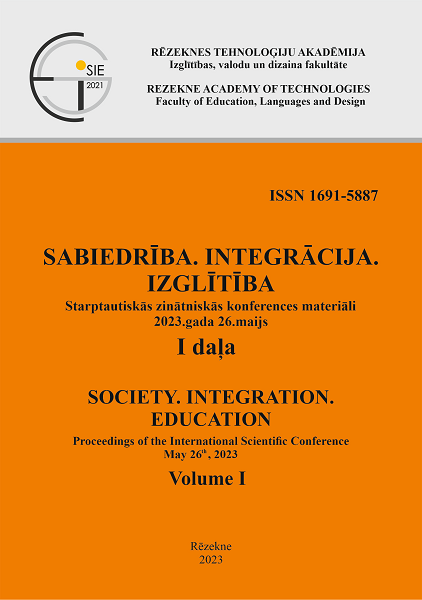21ST CENTURY TEACHER’S TRANSVERSAL COMPETENCIES: THEORETICAL ANALYSIS
DOI:
https://doi.org/10.17770/sie2023vol1.7169Keywords:
21st century skills, modern teacher, transversal competenciesAbstract
In the current situation, a significant part of the existing models of training specialists in the field of education no longer meet the conditions of the labour market. The most important pedagogical skills in the present time are significantly different from the skills that were relevant until recently. Knowledge is still important, but modern teachers also need to have transversal competencies to succeed in their professional activities.
So, the research aim is to study the content of the phenomenon “transversal competences”, which will make the process of their forming more effective.
To achieve the aim the scientific literature and pedagogical practice was analysed. It was found out that transversal competences are transferable and reusable skills that can be applied in a wide variety of situations and work settings. Transversal competencies are considered as 21st century skills and correlate mostly with human ability to solve problems, related to technological advances and intercultural communication.
The analysis of the sources revealed the inconsistency in the use of terms denoting the studied concept and considerable diversity in defining the content of transversal competencies, as different sources distinguish different sets of skills. Based on the framework of transversal competences worked out by UNESCO the modern teacher’s transversal competencies were characterized in six domains: 1) critical and innovative thinking, 2) interpersonal skills, 3) intrapersonal skills, 4) global citizenship, 5) media and information literacy, and 6) others.
Downloads
References
Alnamrouti, A., Rjoub, H., & Ozgit, H. (2022). Do strategic human resources and artificial intelligence help to make organisations more sustainable? Evidence from non-governmental organisations. Sustain. For. 14:7327. DOI: 10.3390/ su14127327
Basadur, M. I. N., Runco, M. A., & Vegaxy, L. A. (2000). Understanding how creative thinking skills, attitudes and behaviors work together: a causal process model. J. Creat. Behav. 34, 77–100. DOI: 10.1002/j.2162-6057.2000.tb01203.x
Belchior-Rocha, H., Casquilho-Martins, I., & Simões, E. (2022). Transversal competencies for employability: from higher education to the labour market. Educ. Sci. 12, 255–275. DOI: 10.3390/educsci12040255
CEDEFOP. (2013). Piloting a European employer survey on skill needs. Luxembourg: Publications Office of the European Union. Retrieved from: https://www.cedefop.europa.eu/files/5536_en.pdf
Collie, R. J, & Martin, A. J. (2016). Adaptability: An important capacity for effective teachers. Educational Practice and Theory, 38(1), 27-39
Ghadermarzi, M., & Mohamadi, R. (2022). Prejudice in the tribal structure of the Arabs and its role in Islam. J. Soc. Sci. Human. Res. 10, 1–6.
International Society for Technology in Education (ISTE). 2015. ISTE Standards for Students. Retrieved from: https://portal.ct.gov/-/media/DAS/CTEdTech/publications/2018/ISTE_Student_Standards_eBook.pdf
Kivunja, C. (2015). Teaching, Learning and Assessment: Steps Towards Creative Practice. Melbourne, Vic.: Oxford University Press
Kovalchuk, V., & Yermak, T. (2021). The development of communication skills of students of secondary school as a component of their leadership potential. Society. Integration. Education: Proceedings of the International Scientific Conference. Volume II. School Pedagogy. Preschool Pedagogy. May 28th-29th, 2021. Rezekne, Rezekne Academy of Technologies, 2021. p. 292–303.
Liu, F., Vadivel, B., Rezvani, E., & Namaziandost, E. (2021). Using games to promote English as a foreign language learners’ willingness to communicate: Potential effects and teachers’ attitude in focus. Front. Psychol. 12:762447. DOI: 10.3389/fpsyg.2021.762447
MacKenzie, J., & Polvere, R.A. (2009). TVET Glossary: Some Key Terms. In: Maclean, R., Wilson, D. (eds) International Handbook of Education for the Changing World of Work. Springer, Dordrecht. DOI: https://doi.org/10.1007/978-1-4020-5281-1_4
Maguire, P., & Pitceathly, C. (2002). Key communication skills and how to acquire them. BMJ 325, 697–700. DOI: 10.1136/bmj.325.7366.697
Pare, G., Kitsiou, S., Lau, F., & Kuziemsky, C. (2017). Methods for Literature reviews. In Handbook of Health Evaluation: An Evidence-Based Approach, University of Victoria, Victoria, B.C. Retrieved from: www.ncbi.nlm.nih.gov/books/NBK481583/
BattelleforKids. (2019). Framework for State Action on Global Education. Retrieved from: http://www.p21.org/storage/documents/Global_Education/P21_State_Fra mework_on_Global_Education.pdf
Stanford Encyclopedia of Philosophy. (2018). Critical thinking. Retrieved from: https://plato.stanford.edu/entries/critical-thinking
The Ontario Public Service. (2016). 21st century competencies: foundation documents for discussion. Retrieved from: www.ontario.ca/education
Thomas, D. R. (2006). A general inductive approach for analyzing qualitative evaluation data. American Journal of Evaluation, Vol. 27 No. 2, pp. 237-246. DOI: https://doi.org/10.1177/1098214005283
Trilling, B., & Fadel, C. (2009). 21st Century Skills: Learning for Life in Our Times. Jossey-Bass/Wiley
Tonekaboni, A. M., & Nasiri, F. (2022). The relationship between Iranian EFL teachers’ self-resiliency and their burn out. J. Soc. Sci. Human. Res. 10, 7–13. DOI: 10.24200/jsshr.vol10iss1pp7-13
UNESCO (2016). School and teaching practices for twenty-first century challenges: lessons from the Asia-Pacific region, regional synthesis report; 2014 regional study on transversal competencies in education policy and practice (Phase II). Retrieved from: https://unesdoc.unesco.org/ark:/48223/pf0000244022
United Nations. (n.y.) Competencies for the Future. Retrieved from: https://careers.un.org/lbw/attachments/competencies_booklet_en.pdf
Whittemore, A. H. (2018). The role of racial bias in exclusionary zoning: The case of Durham, North Carolina 1945–2014. Environ. Plan. 50, 826–847. DOI: 10.1177/0308518x18755144
Wilson, C., Grizzle, A., Tuazon, R., Akyempong, K., & Cheung, C.-K. (2011). Media and Information Literacy Curriculum for Teachers. UNESCO. 192. Retrieved from: https://unesdoc.unesco.org/ark:/48223/pf0000192971


